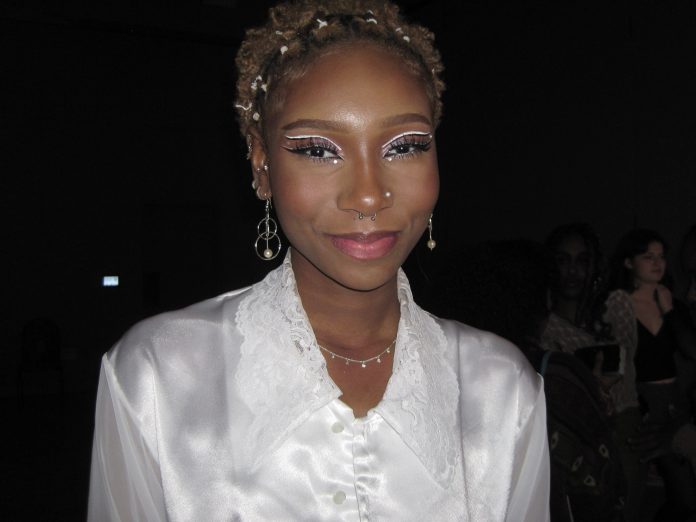When heading to The Bake Shop, take a detour and walk to the intersection of Prince George Street and Scotland Street. There, you’ll find a black obelisk, rising above the lush grass and colorful flowers with a gold plaque shining clear on its side: The MLK Triangle. On this monument are the names and roles of James B. Blayton, Thomas Wise, William Webb, Samuel K. Harris and Charles Gary — all Black business owners who worked on the triangle block before being forced off the land.
Walking through Colonial Williamsburg can feel like taking a step back in time, but beyond the colonial reenactors and the Governor’s Palace, there is a rich history of Black people living and working in Williamsburg that often gets overlooked. Breyonna Rock ’24 has spent her college years working to uncover and share this crucial local history.
Joining the Local Black History Project research group in the summer of 2021, Breyonna has worked with professor Amy Quark to research and create educational materials to inform people about Black history in Williamsburg.
“These are all streets that were mainly Black,” Rock said. “And they really built this community. But because of a series of displacements that happened, starting in the 1940s to the 1970s, they, the city, use eminent domain to buy out people’s property, and they targeted Black communities. And at the time, it’s something that I mean, I’m not sure exactly what they were thinking, but it’s just crazy to think about how intentional this was. And, yeah, that the point of the project is to really preserve its history by talking to descendants of the community.”
In collaboration with The Village Initiative — a not-for-profit organization dedicated to equity and justice in the Williamsburg-James City County Schools and community — the project has created a website detailing Black life in Williamsburg.
“The most accessible way we make sure people have access to this information is through our website,” Rock said. “It’s just called the Local Black History Project website. And there’s so many tabs. There is a page for all histories and oral histories there, usually like an hour to two hours long. And, you curate questions and essentially you’re probing people’s memories, and they’re talking about their childhood and what this area looked like and felt like. And how does it feel to come back to it now?”
Over the course of her tenure with The Local Black History Project, Rock detailed the many tasks she undertook to uncover the history of the area.
“So we’ve done a lot of archival research. I’ve had the opportunity to go to the National Archives in DC, a little bit over a year ago,” Rock said.
“I’ve [also] done quite a few presentations. Actually, as I finish off my final semester, I plan on doing this as a project and hopefully as a teacher. And for one of my classes, last year, around this time, me and a colleague of mine, her name is Annalise, we went to two elementary schools, and we talked about two very pivotal black leaders in Williamsburg. And it was the first black doctor, who had their hospital in the triangle. And then the other leader was Miss Bessie, who was a kindergarten teacher. Before, there was an accessible space for Black children to go to kindergarten,” Rock said.
In talking about the stories of Black people, Rock also reflects on how this project connects to her college experience and how she has grown.
“I feel like my college experience is so tied to this project, and I’m not even sure, the directions I would have gone,” Rock said. “I was like, ‘I’m not even I’m not sure if I would have minored in sociology without this project.’ And I feel like I’ve grown so much. I feel like my lens on the world has certainly changed because of it.”
Having transitioned from a predominantly Black high school, Rock did not truly know what to expect when coming to the College. In terms of her own identity, she has connected with her own background through her work.
“I just also realized that there’s still a lot of progress that has to be made,” Rock said. “I think being here and really experiencing microaggressions and moving through life and being like, oh right, I am the only Black person in the room. But then also working with this project and realizing how much meaning there is, how much Black people have always fought, not only has made me so proud of my identity but also has given me so much purpose. I feel like it really drives me to be better.”
Alongside her work, Rock serves as the President of the College’s Black Student Organization. Reflecting on the community, Rock expressed immense gratitude and joy for the organization.
“I would not trade it for the world,” Rock said. “It only enhanced my experience, especially, alongside my work with the Local black history project, I feel like it only made me more pro-Black. And just so much prideful and so much more prideful in the way I feel like I can talk to my fellow Black students, in a way where it’s like we can both identify our place on this campus, and also feel uplifted.”
Upon reflecting on her experiences, Rock advises students to go for opportunities and be open to the experiences college has to offer.
“Find where you fit and just being open to that and also seeking things out that fit you,” Rock said “If you’re looking for things that align with your interests, like ask around, or apply for a job, or search for opportunities, and that’s just like a segue to get you started.”

